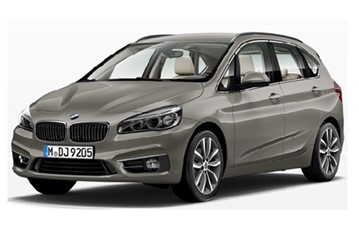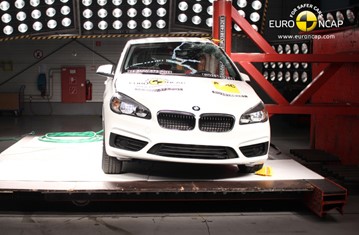Find more information in the General Comments section of the assessment
Find more information in the Rating Validity tab of the assessment
- See More
- See More
- See More
- See More
- Good
- Adequate
- Marginal
- Weak
- Poor
 Passenger
Passenger
 Driver
Driver
 Rear Seat
Rear Seat
 Front Seat
Front Seat
 Car
Car
 Pole
Pole
- Good
- Adequate
- Marginal
- Weak
- Poor


Passenger
outboard
center
Fitted to the vehicle as standard
Not fitted to the test vehicle but available as option
Not Available
-
Infants up to 13 kg
-
Infants and toddlers up to 18 kg
-
Toddlers from 9 to 18 kg
-
Toddlers over 18 kg
Easy
Difficult
Safety critical
Not allowed
| Seat Position | ||||
|---|---|---|---|---|
| Front | 2nd row | |||
| Passenger | Left | center | Right | |
| Maxi Cosi Cabriofix (Belt) | ||||
| Britax Römer King Plus (Belt) | ||||
| Britax Römer Duo Plus (ISOFIX) | ||||
| Britax Römer KidFix (Belt) | ||||
| Maxi Cosi Cabriofix & EasyFix (Belt) | ||||
| Maxi Cosi Cabriofix & EasyFix (ISOFIX) | ||||
| BeSafe iZi Kid X3 ISOfix (ISOFIX) | ||||
| Maxi Cosi Pearl & Familyfix (ISOFIX) | ||||
| Britax Römer KidFix (ISOFIX) | ||||
Easy
Difficult
Safety critical
Not allowed
The 2 Series Active Tourer scored maximum points in the dynamic tests for its protection of both the 1½ year and the3 year dummy. Both dummies were sat in rearward-facing restraints, providing the best form of protection in the frontal impact. In the side barrier test, both dummies were properly contained within the protective shells of their restraints, minimising the likelihood of dangerous head contact with the vehicle interior. The front passenger airbag can be disabled to allow a rearward-facing child restraint to be used in that seating position. Clear information is provided to the driver regarding the status of the airbag and the system was rewarded. All of the restraints for which the car is designed could be properly installed and accommodated in the vehicle.
- Good
- Adequate
- Marginal
- Weak
- Poor

Head Impact 14.9 Pts
Pelvis Impact 2.0 Pts
Leg Impact 4.9 Pts
The BMW 2 Series Active Tourer has an active bonnet which lifts when a pedestrian is struck to provide greater clearance to the hard structures in the engine compartment. BMW demonstrated that the system would detect a range of pedestrian statures over a wide range of speeds, so the car was tested with the bonnet in the deployed position. On the bonnet surface, the protection offered to a pedestrian's head was good or adequate almost everywhere. Some poor results were recorded at the base of the windscreen and on the stiff windscreen pillars. The front edge of the bonnet performed well towards the centreline of the vehicle but gave poor results elsewhere. The bumper offered mixed protection to pedestrians' legs, ranging from good to marginal.
- Good
- Adequate
- Marginal
- Weak
- Poor
| Speed Limitation Function | Manually Set |
| System Name | DSC | |
| Performance | ||
| Applies To | All seats | ||
| Warning | Driver Seat | Front Passenger(s) | Rear Passenger(s) |
| Visual | |||
| Audible | |||
|
|||
| System Name | Approach Warning with City Brake Activation | |||
| Type | Forward Collision Warning with Auto-Brake | |||
| Operational From | 1 km/h | |||
| Additional Information | Default On | |||
| Performance | | ||||
| Autobrake Function Only | Driver reacts to warning | |||
| Operational Speed | 1-99 km/h | 1-99 km/h | ||
| Approaching a stationary car | See AEB City | Crash avoided up to 65km/h.Crash speed reduced up to 80km/h. | ||
| Approaching a slower moving car | Crash avoided up to 40km/h.Crash speed reduced up to 70km/h. | Crash avoided up to 80km/h.Crash speed reduced up to 0km/h. | ||
| Following a car at short distance | ||||
| Car in front brakes gently | Mitigation | Avoidance | ||
| Car in front brakes harshly | Mitigation | Mitigation | ||
| Following a car at long distance | ||||
| Car in front brakes gently | Mitigation | Avoidance | ||
| Car in front brakes harshly | Mitigation | Avoidance | ||
The 2 Series Active Tourer has electronic stability control as standard equipment. A seatbelt reminder is standard for the front and rear seats. An autonomous emergency braking system is standard equipment and, in Euro NCAP's tests, showed adequate performance. A driver-set speed limitation device is available as an option but is expected to be fitted to most cars sold. The system met Euro NCAP's requirements for speed-limiters of this type. A lane-keeping aid is also an option but was not included in the assessment as it is not expected to be fitted to most cars sold.
- Specifications
- Safety Equipment
- Videos
- Advanced Rewards
- Rating Validity
Specifications
Tested Model BMW 2 Series Active Tourer 1.5 Base, LHD
Body Type - 5 door hatchback
Year Of Publication 2014
Kerb Weight 1320kg
VIN From Which Rating Applies - applies to all 2 Series of the specification tested
Class Small Family Car
Safety Equipment
Note: Other equipment may be available on the vehicle but was not considered in the test year.
Fitted to the vehicle as standard
Fitted to the vehicle as option
Not fitted to the test vehicle but available as option
Not Available
Not Applicable
Videos
Advanced Rewards
Rating Validity







Find more information in the General Comments section of the assessment
 Share
Share










The passenger compartment remained stable in the frontal impact. The passenger dummy showed good protection of all critical parts of the body. Dummy readings indicated good protection of the knees and femurs of both the driver and passenger. BMW showed that a similar level of protection would be provided to occupants of different sizes and to those sat in different positions. However, injury parameters indicated weak protection of the driver's lower legs. In the side barrier test, the 2 Series Active Tourer scored maximum points, with good protection of all body regions. Even in the more severe side pole test, the car scored maximum points with good protection of all areas, most notably the chest. Tests showed that the front seats and head restraints would provide good protection against whiplash injury in the event of a rear-end collision and a geometrical assessment of the rear seats also indicated good protection. Moreover, the 2 Series Active Tourer has a standard-fit autonomous emergency braking system that works at low speeds typical of city driving. Euro NCAP's tests showed that collisions could be avoided at speeds up to 20km/h and collision severity mitigated at higher speeds, up to 50km/h.